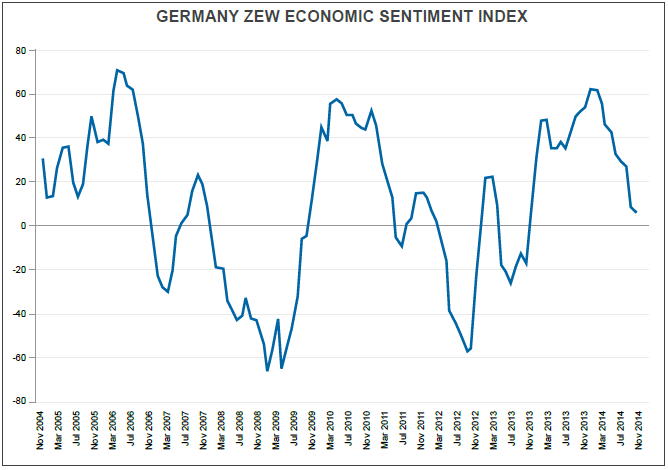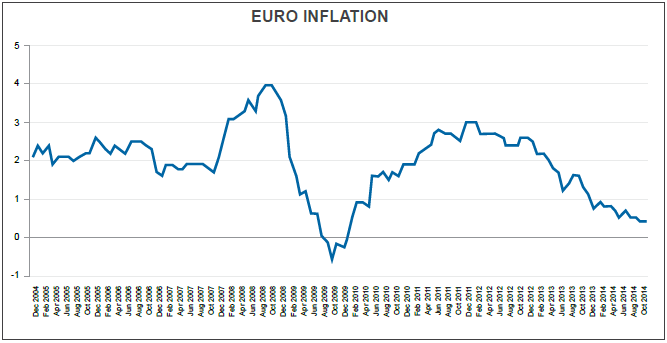Eurozone Outlook
Low inflation continues to taunt the ECB despite some indicators picking up. The debate is now whether a QE programme is needed to boost inflation.
GROWTH EXPECTATIONS:
Eurozone GDP has ticked higher in the third quarter of 2014 but is still worryingly low at 0.2% q/q. This is an improvement on the 0.0% seen in the second quarter and puts annual growth at 0.8% higher than a year ago. France has led the way with 0.3% quarterly GDP growth, with Germany just registering in the positives at 0.1% q/q and Italy remaining in recession at -0.1% q/q.
The European Central Bank (ECB) has been watching these growth rates closely and the speculation is now rife that they will add further stimulus in the first quarter of 2015 to combat the low growth rates. Unemployment was steady throughout the quarter for the EU, remaining at 11.5%. The Spanish Unemployment rate has continued to make the most impressive moves falling from 24.5%to 23.7%.
The ZEW economic sentiment reports gave the ECB great cause for hope in December as the German figure turned its biggest rise in two years. German economic sentiment rose from 11.5 to 34.9 and EU-wide economic sentiment rose from 11.0 to 31.8. This could be the proof the ECB is looking for to show that their stimulus packages are having the desired effect.

The PMI figures were more of a mixed bag than the economic sentiment reports. French manufacturing and services remain stubbornly rooted in contractive territory at 47.9 and 49.8 respectively. German Manufacturing dipped below 50 in October but managed to close the year in expansion at 51.2.
MONETARY POLICY:
During the quarter, the interest rate was held all threetimes at -0.20% for deposits and the refinancing rate atjust 0.05%. There have been plenty of hints from ECB President Mario Draghi that a stimulus package in the form of Quantitative Easing (QE) is a distinct possibility.The market was not expecting a change in interest rates, however, many were expecting QE to be announced.The market now looks forward to it in early 2015, with the euro suffering as a result of the speculation.
Stubbornly low Inflation has remained a problem for the ECB, which explains all the talk of further stimulus. Headline CPI for the EU is at just 0.3% y/y. This did tickup to 0.4% in October and November, but fell back in December. The positive for the ECB is that inflation looks to have bottomed out as the effects of the stimulus and the weaker euro work its way through.

FX OUTLOOK:
The euro has performed more or less as expected over the quarter. Mario Draghi continued to talk down the euro as he hinted at a QE programme that will see the ECB purchase government debt. The euro found brief levels of support as the stimulus was not forthcoming, however, the likelihood of stimulus and the strength of the US economy has pushed the euro below the 1.20 mark.
Looking forward to the first quarter of 2015 could be another bearish quarter for the EUR/USD pair. The strength in the US economy is likely to continue, and the US dollar will benefit from this and the prospects of the US FED raising interest rates. At the other end of the scale is the ECB looking to add more stimulus which should push the EUR/USD pair further down.
EQUITY OUTLOOK:
The DAX has had a choppy ride during the final quarter of 2014. It briefly touched an all-time high on 5th December but could only manage two closes above the 10,000 point level before the absence of further stimulus and political turmoil in Greece pegged it back. The trouble in the Russian markets and a collapse of commodity prices saw volatility across the board. Volatility in European stock indices as well as global stock markets is a trend that is likely to continue into 2015 and diverging monetary policies looks set to be a major theme.
